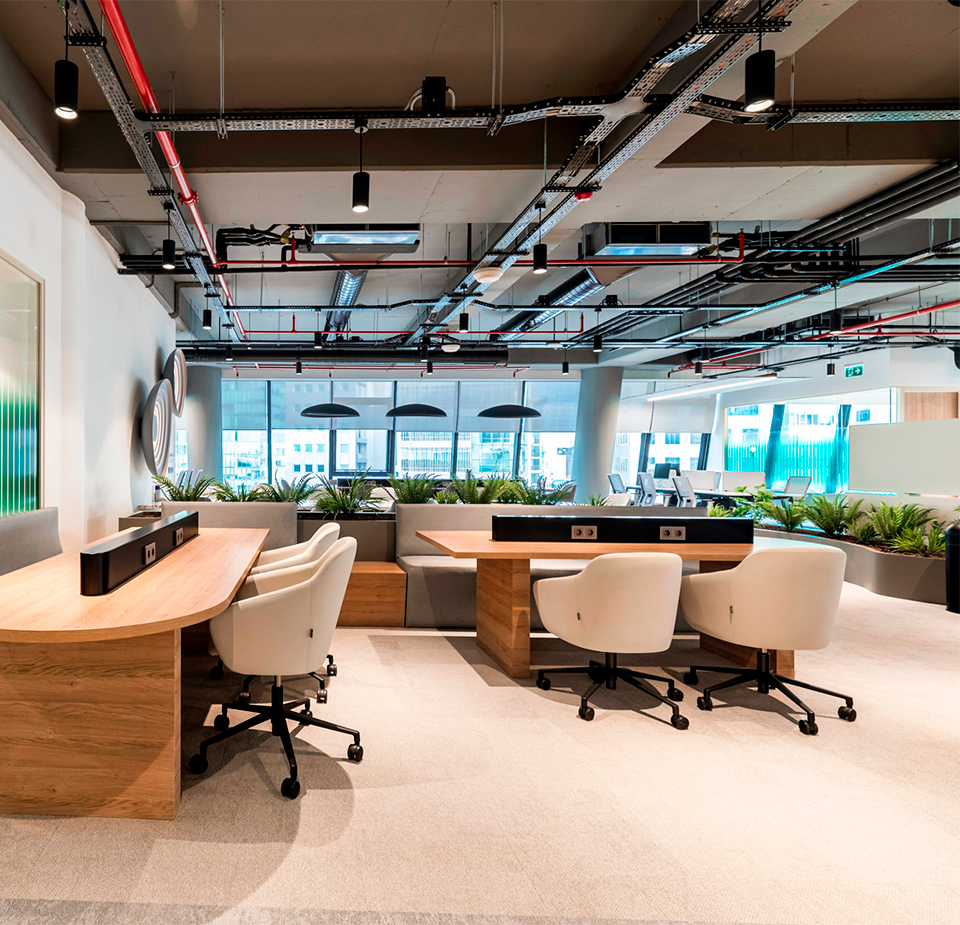-
The rise of remote work has highlighted the importance of creating comfortable and functional home office setups. Employees now require dedicated spaces that promote focus, minimize distractions, and support virtual collaboration tools. However, the transition to remote work also poses challenges, such as social isolation, blurred boundaries between work and personal life, and difficulty maintaining team cohesion.
-
-
-
Hybrid work models, which combine remote and in-office work, have emerged as a compromise between the flexibility of remote work and the benefits of face-to-face interactions. This approach requires rethinking workspace design to accommodate a fluid workforce that seamlessly moves between different work environments.
-
-
ESSENTIAL ELEMENTS OF PRODUCTIVE WORKSPACES
Designing productive workspaces in the era of remote and hybrid work requires a holistic approach that considers various factors, including:
Ergonomics: Comfortable and adjustable furniture, proper lighting, and noise control measures are essential for reducing physical strain and promoting focus.
Technology Integration: Seamless integration of video conferencing tools, collaborative software, and secure networking infrastructure is crucial for enabling effective virtual collaboration.
Flexibility and Adaptability: Workspaces should be designed to accommodate diverse work styles, team sizes, and project requirements. Modular furniture, movable partitions, and reconfigurable layouts allow easy adaptation to changing needs.
Biophilic Design: Incorporating natural elements, such as plants, natural lighting, and outdoor views, can improve employee well-being, reduce stress, and enhance productivity.
Privacy and Focus Zones: While collaboration is essential, employees also require dedicated spaces for focused work and confidential conversations. Quiet rooms, phone booths, and enclosed workstations provide the necessary privacy and minimize distractions.
-
Collaboration Hubs: Collaborative spaces, such as huddle rooms, open meeting areas, and project rooms, facilitate team interactions, brainstorming sessions, and knowledge sharing.
Amenities and Wellness Spaces: Amenities like cafeterias, fitness centers, and outdoor spaces can contribute to a sense of community, promote work-life balance, and support employee well-being.
-
-
CREATING A BALANCE BETWEEN COLLABORATION AND PRIVACY
One key challenge in designing productive workspaces is balancing collaboration and privacy. While open-plan layouts can foster spontaneous interactions and knowledge sharing, they can also contribute to noise distractions and a lack of privacy, negatively impacting productivity and focus.
Workspace designers are exploring innovative solutions incorporating various zones and flexible configurations to address this challenge. For example, a workspace might feature:
-Collaboration Zones: These are open areas with movable furniture, whiteboards, and digital displays to encourage teamwork and brainstorming sessions.
-Focus Zones are enclosed or semi-enclosed spaces with sound-absorbing materials and minimal visual distractions designed for individual focused work.
-Hybrid Zones: Multipurpose areas that can be easily reconfigured for different activities, such as team meetings, presentations, or individual work.
-
-
THE FUTURE OF WORKSPACE DESIGN: TRENDS AND PREDICTIONS
As the workplace continues to evolve, several trends and predictions are shaping the future of workspace design:
-
-
Increased Flexibility and Mobility: Workspaces will become more adaptable and mobile, with furniture and technology designed for easy reconfiguration and relocation. This will accommodate the fluid nature of hybrid work and enable employees to work seamlessly across different environments.
Emphasis on Employee Well-being: There will be a greater focus on designing workspaces that prioritize employee well-being, including biophilic elements, ergonomic furniture, and dedicated wellness spaces for activities like yoga, meditation, or relaxation.
Smart Building Technology: Integrating Internet of Things (IoT) devices, sensors, and artificial intelligence (AI) will enable intelligent building management systems that optimize energy efficiency, indoor air quality, and space utilization.
Coworking and Shared Spaces: The rise of coworking spaces and shared office environments will continue, offering flexible and cost-effective solutions for remote workers, freelancers, and small businesses.
Sustainable and Circular Design: Sustainability will become a key consideration in workspace design, emphasizing using eco-friendly materials, minimizing waste, and implementing circular economy principles.
Virtual and Augmented Reality: Adopting virtual and augmented reality (VR/AR) technologies will enable immersive collaboration experiences, virtual meetings, and interactive training sessions, blurring the boundaries between physical and digital workspaces.
Personalization and Customization: Workspaces will become more personalized and customizable, allowing employees to tailor their environments to their preferences and work styles.
-
-
The future of work is rapidly evolving, and workspace design must adapt to meet the changing needs of remote and hybrid work models. Organizations can create productive workspaces that foster collaboration, innovation, and overall employee satisfaction by embracing flexibility, technology integration and focusing on employee well-being.







